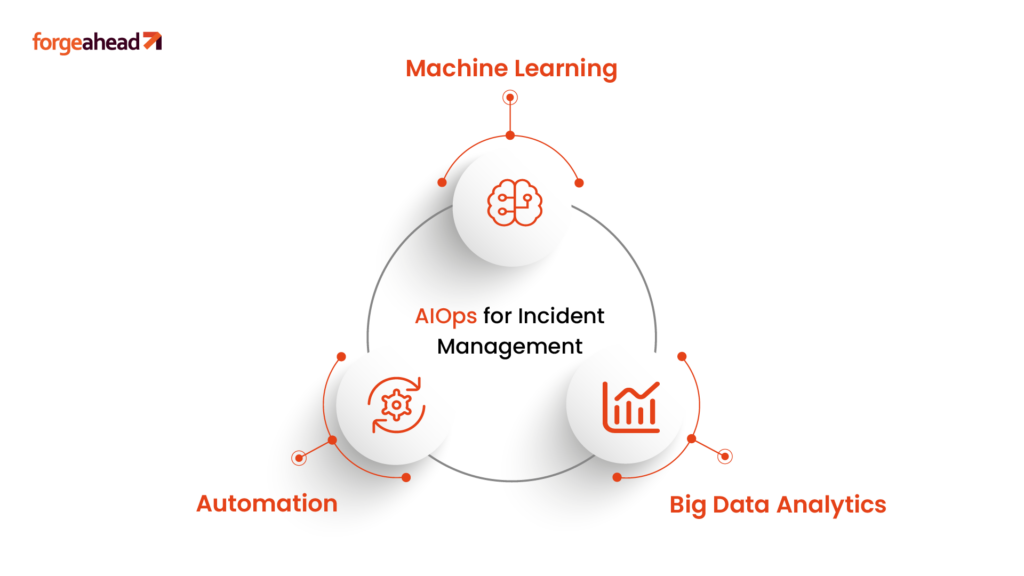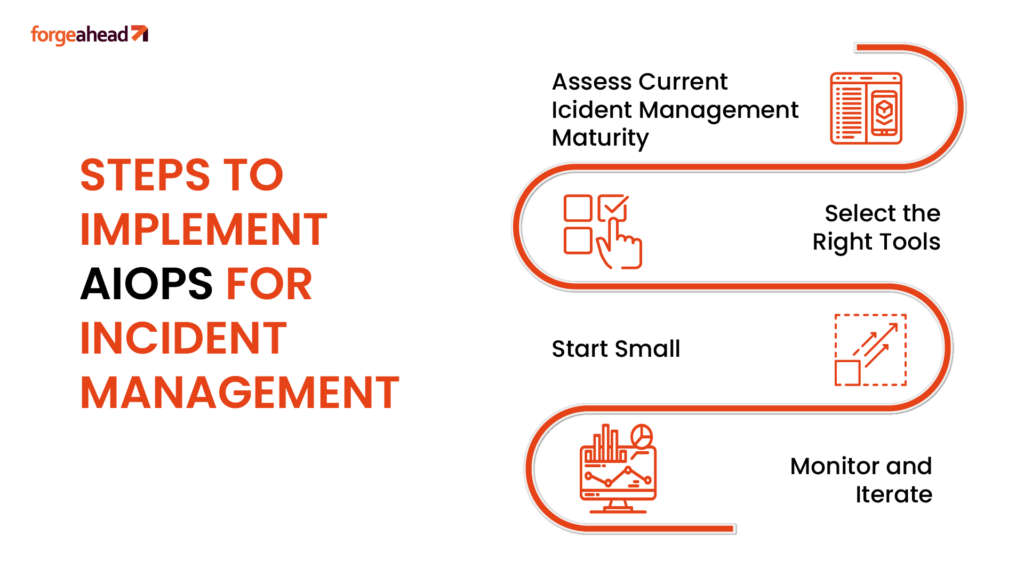Last updated on October 21st, 2024
Think back to the last major incident.
Your team probably spent hours sifting through logs, analyzing data, and jumping from one tool to another, right?
Now, imagine having all that data analyzed in real-time, predicting potential issues before they escalate.
That’s the magic of AIOps—taking your incident management from a reactive firefight to a proactive powerhouse.
Let’s explore how AIOps can be the game-changer your IT operations need.
Key Components of AIOps for Incident Management

When we talk about AIOps in incident management, three core components stand out:
| Component | Description | Benefit |
| Machine Learning | Uses pattern recognition to identify and predict incidents in real-time, adapting to the IT environment’s behavior over time. | Proactive issue detection, reduced false positives. |
| Big Data Analytics | Aggregates and analyzes vast amounts of data from various sources to provide comprehensive incident analysis. | Faster root cause identification, improved incident context. |
| Automation | Automates routine tasks and enables rapid response and resolution of incidents. | Reduces manual effort, accelerates recovery time. |
Implementing AIOps in Incident Management
Implementing AIOps might seem daunting, but it doesn’t have to be. Here’s a step-by-step approach to get started:
- Assess Your Current Incident Management Maturity: Identify gaps in your current processes. How many incidents are you managing manually? This assessment will guide your AIOps implementation plan.
- Select the Right Tools: There are various AIOps tools available; choose one that integrates well with your existing systems and offers scalability.
- Start Small: Implement automation for routine tasks first. Gradually scale up to more complex scenarios like predictive incident management. A phased approach minimizes disruption.
- Monitor and Iterate: Set performance metrics (MTTR, incident volume, etc.) to measure the impact. Use these insights to fine-tune your AIOps deployment.

Some teams may resist adopting AIOps due to fear of change. Address these concerns with training and by highlighting AIOps’ role in reducing burnout.
Benefits of AIOps in Incident Management
Why should your organization adopt AIOps? Here’s what you gain:
- Faster Incident Detection: Machine learning models enable instant detection of anomalies, improving system uptime.
- Improved Root Cause Analysis: Big data analytics quickly identify the root cause, minimizing downtime.
- Reduction in False Positives: AIOps filters noise and focuses on actionable alerts, reducing alert fatigue.
- Automated Resolution: Routine issues are resolved automatically, allowing IT teams to concentrate on more complex tasks.
- Enhanced Predictive Maintenance: AIOps uses historical data to predict potential failures, enabling proactive maintenance.
- Increased Operational Efficiency: Automation streamlines incident management, reducing mean time to resolution (MTTR).
- Improved Service Level Agreements (SLAs): Faster response times help meet and exceed SLAs, boosting customer satisfaction.
- Cross-Team Collaboration: AIOps tools integrate with IT Service Management (ITSM) platforms, facilitating coordinated responses across IT teams.
AIOps and IT Service Management (ITSM)
AIOps integrates seamlessly with IT Service Management (ITSM) tools to elevate IT processes.
Think about the delays caused by manual ticketing or missed Service Level Agreements (SLAs). AIOps can:
- Enhance ITSM: By automatically prioritizing incidents based on impact, AIOps helps IT teams tackle the most critical issues first.
- Integrate with ITSM Tools: Platforms like ServiceNow can integrate with AIOps solutions to automate ticket creation, assignment, and resolution tracking.
- Improve SLA Compliance: Faster resolution times lead to improved compliance with SLAs,
Case Studies
Take the example of Nokia, a leading telecommunications company.
Nokia integrated AIOps into its IT operations to tackle the increasing volume and complexity of network issues.
Before AIOps, Nokia faced a lengthy Mean Time to Resolution (MTTR) due to manual monitoring and troubleshooting. However, after adopting AIOps, they saw a major reduction in MTTR, drastically improving system uptime and overall network performance.
The Human Factor in AIOps
Is AIOps all about replacing humans? Not at all. It’s about enhancing human capabilities.
In an AIOps environment, IT professionals’ roles shift from manual firefighting to strategic oversight. New skills are required:
- Data Analysis: Understanding AIOps-generated insights to make informed decisions.
- Automation Management: Knowing when to let AIOps take the wheel and when to intervene.
- AI Ethics: Ensuring AIOps operates within ethical boundaries and safeguards privacy.
- Are your IT teams ready for this shift? Investing in upskilling and training is crucial to AIOps success.
Future Trends in AIOps for Incident Management
AIOps is evolving rapidly. Predictive and prescriptive incident management are on the horizon, where AI will not just identify potential issues but also recommend preventive actions.
Are you prepared for these changes? The future will see more integrated AIOps solutions that work seamlessly across all layers of IT infrastructure.
Ethical Considerations and Limitations
While AIOps brings numerous benefits, ethical considerations cannot be overlooked.
Ensuring transparency in AI-driven decisions is crucial to maintain trust. There’s also the concern about job displacement.
However, AIOps aims to augment human roles, not replace them. A balanced approach that combines automation with human expertise is key.
Ending Thoughts
AIOps is transforming IT incident management, making it faster, smarter, and more proactive. From predicting incidents to reducing alert fatigue, the benefits are clear.
Is your IT team ready to make the shift? If so, Forgeahead can help you take the first step toward a more efficient, AI-driven future.
FAQ
1. How does AIOps improve traditional incident management processes?
AIOps uses machine learning to analyze data in real-time, predict potential incidents, and automate responses, reducing manual intervention and enhancing accuracy.
2. What are the key steps to implement AIOps in an organization’s incident management?
Assess your current maturity, choose the right tools, start with routine automation, and iterate based on performance metrics.
3. How does AIOps integration affect existing ITSM frameworks and tools?
AIOps enhances ITSM by automating workflows, integrating with tools like ServiceNow, and providing real-time insights for improved incident prioritization and SLA compliance.
4. What skills should IT teams develop to effectively work with AIOps?
Teams should focus on data analysis, basic AI/ML knowledge, automation tools, cloud infrastructure understanding, and cross-functional collaboration.
5. Can AIOps completely automate incident management, or is human intervention still necessary?
Human intervention is still needed for complex incidents and strategic decisions, while AIOps handles routine tasks and provides actionable insights.
6. How does AIOps help in reducing alert fatigue and improving incident prioritization?
AIOps filters noise, focuses on critical alerts, and prioritizes incidents based on impact, helping IT teams address the most urgent issues efficiently.



